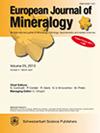采尔马特-萨斯地区(瑞士)榴辉岩相石榴石中OH的结合和保留及其对深水循环的贡献
IF 1.7
3区 地球科学
Q2 MINERALOGY
引用次数: 0
摘要
摘要利用傅里叶变换红外光谱(FTIR)和电子探针显微分析(EPMA)相结合的方法,研究了瑞士采尔马特-萨斯地区一组高压岩石中石榴石中OH基团的结合机理。已研究的石榴石标本包括榴辉岩、基性森林和变质沉积物中的榴辉岩-铁榴石-铁榴石固溶体以及榴辉岩-铁榴石-辉石-铁榴石固溶体。所有岩石都经历了相同的峰值变质条件,对应于埋藏深度约80公里(约540°C, 2.3 GPa),从而可以测定石榴石中OH含量作为岩石类型的函数。OH并入石榴石的能力很大程度上取决于石榴石的组成。富andradite(400-5000µg g−1 H2O)和富grossulal -石榴石(200-1800µg g−1 H2O)比富almandinal -石榴石(< 120µg g−1 H2O)含有至少一个数量级的水。使用ftir和EPMA剖面和地图的微观分析揭示了整个样品变质历史中OH分区的保存。OH含量与Mn, Ca和Ti的区带密切相关,并产生不同的吸收带,这是多个纳米级OH环境的特征。二维扩散模型的使用表明,在540°C时,氢在这些岩石中的扩散率为log(D[m2 s−1])=−24.5。收集了Zermatt-Saas地区主要含石榴石岩石类型的数据,计算了H2O的质量平衡模型。结果表明,在80 km深度以上的俯冲板块中,石榴石可输送~ 3360 kg H2O km - 1(洋壳剖面)yr - 1,参与了皮埃蒙特-利古里亚洋始新世俯冲过程中的深地球水循环。本文章由计算机程序翻译,如有差异,请以英文原文为准。
OH incorporation and retention in eclogite-facies garnets from the Zermatt–Saas area (Switzerland) and their contribution to the deep water cycle
Abstract. The incorporation mechanisms of OH groups in garnet were
investigated in a suite of high-pressure rocks from the Zermatt–Saas area
(Switzerland) using a combination of Fourier transform infrared spectroscopy
(FTIR) and electron probe micro-analysis (EPMA). Investigated garnet
specimens include grossular–andradite–uvarovite solid solutions in
serpentinite and rodingite and almandine–grossular–pyrope–spessartine
solid solutions in eclogite, mafic fels and meta-sediment. All rocks
experienced the same peak metamorphic conditions corresponding to a burial
depth of ∼ 80 km (∼ 540 ∘C, 2.3 GPa),
allowing determination of the OH content in garnet as a function of rock
type. The capacity for OH incorporation into garnet strongly depends on its
composition. Andradite-rich (400–5000 µg g−1 H2O) and
grossular-rich garnet (200–1800 µg g−1 H2O) contain at
least 1 order of magnitude more H2O than almandine-rich garnet
(< 120 µg g−1 H2O). Microscale analyses using FTIR
and EPMA profiles and maps reveal the preservation of OH zoning throughout
the metamorphic history of the samples. The OH content correlates strongly
with Mn, Ca and Ti zoning and produces distinct absorption bands that are
characteristic of multiple nano-scale OH environments. The use of 2D
diffusion modelling suggests that H diffusion rates in these rocks is as low
as log(D[m2 s−1]) = −24.5 at 540 ∘C. Data were
collected for the main garnet-bearing rock types of the Zermatt–Saas area
allowing a mass balance model of H2O to be calculated. The result shows
that ∼ 3360 kg H2O km−1 (section of oceanic crust) yr−1
could be transported by garnet in the subducting slab beyond 80 km depth and
contributed to the deep-Earth water cycle during the Eocene subduction of
the Piemonte–Liguria Ocean.
求助全文
通过发布文献求助,成功后即可免费获取论文全文。
去求助
来源期刊
CiteScore
2.80
自引率
9.50%
发文量
40
审稿时长
6-12 weeks
期刊介绍:
EJM was founded to reach a large audience on an international scale and also for achieving closer cooperation of European countries in the publication of scientific results. The founding societies have set themselves the task of publishing a journal of the highest standard open to all scientists performing mineralogical research in the widest sense of the term, all over the world. Contributions will therefore be published primarily in English.
EJM publishes original papers, review articles and letters dealing with the mineralogical sciences s.l., primarily mineralogy, petrology, geochemistry, crystallography and ore deposits, but also biomineralogy, environmental, applied and technical mineralogy. Nevertheless, papers in any related field, including cultural heritage, will be considered.

 求助内容:
求助内容: 应助结果提醒方式:
应助结果提醒方式:


